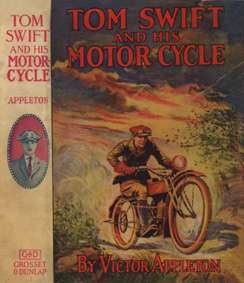
Tom Swift and His Motor-Cycle
Or, Fun Adventures on the Road Book #1
By Victor Appleton
Review by JP Karenko, 3/28/05, Updated August 2006
Full-color image from the collection of James D. Keeline
Duotone image from the collection of Mark Snyder

Note: Some of the language, references & attitudes, while acceptable at the time they were written, are not Politically Correct, today.
Summary: No official summary was ever provided with any of the old Tom Swift books. However, without giving too much away, the plot can be summed up as follows:
The book opens with Tom on an errand for his father. He is on a bicycle, and is nearly run down by one Andy Foger, a red-haired squinty-eyed bully, who is trying to get his new automobile to go as fast as possible. Andy ends up in a ditch, and blames Tom. (This may be the first documented case of "road-rage.") Later on that same trip, Tom encounters one Wakefield Damon, who crashes his new motor-cycle against a tree near Tom's house and is injured. Tom buys the wreck and repairs it, thus leading to his Adventures On the Road.
Tom was been given charge by his father of delivering important patent documents and a proof-of-concept model to an attorney in distant Albany, NY. Those documents, along with the model, a new turbine engine developed by Tom's father Barton, are the central anchor around which the rest of the story revolves.
Barton's turbine design and model are stolen by a gang, posing as tramps. The gang are hired by frustrated investors, seeking to "get ahead" of Barton and capitalize on the new design. The gang attacks Tom and drugs him during his road trip to Albany. Tom escapes, and after some serious detective work, finds the bad-guys' hideout. With the help of Mr. Damon and several other men, Tom recovers the stolen items. The bad guys slip away in the confusion, to return in future episodes.
The first 25 books in this series are available on-line at the Project Gutenberg website:
Go to
http://www.gutenberg.org/browse/authors/a and search on "Tom
Swift."
![]()
Cast of Characters (More or less in order of appearance)
Andy Foger--Red haired, squinty-eyed
bully, who makes great trouble for Tom. "Poor little rich kid." Son of wealthy
family and born with a chip on his shoulder. Reckless, blustery and angry. A
showoff.
Sam Snedecker--Cohort of Andy Foger. Voice of reason to Andy's scream of rage. No description given.
Unnamed 3rd & 4th cohorts--Passengers in Andy's car. No names or descriptions.
Tom Swift--Intrepid inventor & mechanical genius. Plucky, resourceful, brave and clever. (handsome, too...) Home-schooled at a college level by his father, Barton Swift. Athlete and hunter. Familiar with how to stalk game and firearms. Loves all things scientific.
Barton Swift--Widower. Wealthy but conservative and not flashy or pretentious. Inventor master machinist and holder of numerous patents. Elderly and in poor health from overwork.
Mrs. Baggert--Housekeeper and surrogate mother to Tom. Employed by the Swift family for 10 years at the time of this story. She is kindly and like a 2nd mother to Tom. Willing to feed tramps that come by looking for a meal.
Mr. Wakefield Damon--Elderly & eccentric adventurer whose main purpose in life seems to be blessing everybody and everything near his person. He nearly runs Tom off the road, while trying to control his new Motor-Cycle, and is later injured when the machine tries to "climb a tree." In this tome, he "resides in nearby Waterfield," and suffers from "liver ailments." Self-described as "too stout to walk," and "cannot run." Apparently quite wealthy.
Mr. Merton--NFN (No First Name) given. Contract machinist in Mansburg, who makes special-order parts for the Swifts. Suspected leak for some of Swifts' secrets.
Smeak & Katch--Unscrupulous Washington D.C. law firm, employed by unnamed financier(s) that try to steal Barton Swift's turbine.
Reid & Crawford--Scrupulous Washington D.C. law firm representing Barton Swift.
The "Happy Harry" Gang--Not named as such, but surmised from the description of the four members. These guys show up singly and in groups throughout this story, and later.
Jake Burke, A.K.A. "Happy Harry"--Ringleader & brains of the outfit. Educated, and plays the part of a tramp, but poorly. Bushy brown beard, and tattoo of a ring on the small finger of his left hand. Hired as sneak-thief and industrial spy by unnamed "financiers" trying to steal Barton Swift's turbine plans.
Anson Morse--"Snappy dresser" who wears kid gloves. Black moustache. Uses a false beard while playing the part of a bum, trying to steal the turbine plans. A sneak-thief who steals papers from Swift property.
Featherton, A.K.A. "Simpson"--NFN given. Thug / muscle for gang. Knows knockout techniques and drugs. Acts as chauffeur/driver for the gang.
Appleson--NFN given. Thug / muscle for gang.
Eradicate Andrew Jackson Abraham Lincoln Sampson, A.K.A. Rad--Aged stereotypical Negro journeyman jack-of-all-trades. Chicken-coop cleaner and whitewasher. "Eradicates dirt." Also makes a living mowing grass, and sawing wood. Gives the appearance of being lazy, but is actually a hard worker and entrepreneur/wheeler-dealer. Heavy deep-south accent and Uncle Remus attitude. Caretaker of mule Boomerang.
Miss Mary Nestor--Saved by Tom when her horse & wagon run away. Cameo appearance, early in story. Described as a "fair young woman." Resides in Mansburg, with her father, Amos.
Amos Nestor-- Mary's father. Passing mention only.
Ned Newton--Chum & soon-to-be constant companion of Tom, is currently employed in a Shopton bank. Cameo appearance near the beginning of this story, but has no active part beyond that.
Garrett Jackson--Aged "engineer" who runs and maintains the steam plant and engine(s) used to power the Swift's belt-driven machine tools. Lives in a shack on the Swift property.
Theodore Duncan--Hunter who aids Tom after his Motor-Cycle is sabotaged by Happy Harry.
Blackford Family--Farm family who render aid to Tom after he is waylaid by Happy Harry Gang.
Amos Blackford--Farmer & Head of Household.
Mrs. Blackford--NFN given. Wife of Amos, kindly & compassionate toward Tom.
Jeb Blackford--Son of Amos, farmer & part-time Deputy Sheriff.
Vigilantes--Touring chums of Wakefield Damon.
Messrs. Munson, Dwight & Benson--Brave, but inept impromptu posse that help Tom recover the plans and patent model. Bad guys escape in spite of being surrounded.
![]()
Major Inventions
Tom Swift didn't really "invent" anything in this book. He did do some engineering development work on his new toy, though, by changing sprocket ratios and improving the gasoline and spark levers on his cycle. These changes, along with a larger fuel tank, improved the performance of the machine, increasing the range and the stated top speed by some 15%. Tom's cycle had pedals, which were used to get the bike up to a speed where the clutch could be let out, thus starting the motor. Kick starters and electric assist had not yet been thought-of. Cost of such a machine was in the $200-250 range.
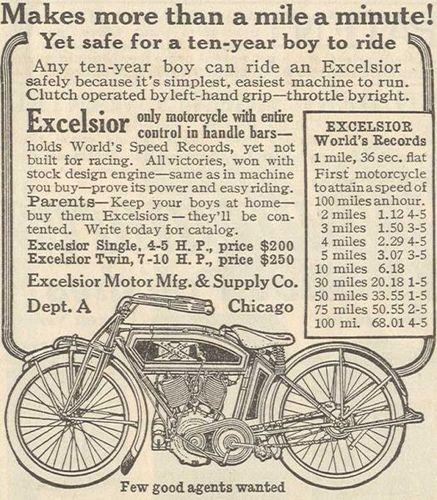
1910 era Motor Cycle Advertisement
It was later noted, almost as an aside, that Tom had applied for a patent on an improved boat motor propeller, probably to establish his bona-fides as a true inventor like his father, Barton. Tom did demonstrate a consistent ability to diagnose and repair poorly designed or "out-of-order" machinery. He managed to fix Eradicate Sampson's wagon brake, a lawn-mower, and a treadmill powered wood saw. He also repaired a gear-driven butter churn for Mrs. Blackford.
![]()
Commentary On Society, Attitudes, Environment & Errata
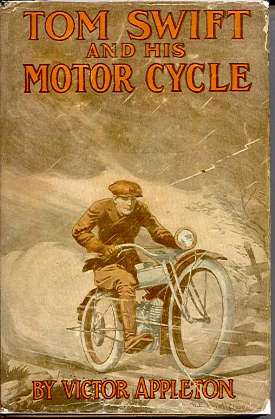 It's
amazing how much society and technology have changed. Reading the old Tom Swift
Sr. series has really given me an appreciation of all the modern gadgets that
I've come to take for granted. It also has helped me to grasp how far and how
fast we have come. I wonder what people will be taking for granted 100 years
from now. At this reading in 2005, this book is 95 years old. The list price of
this volume was $0.40 postpaid from the publisher.
It's
amazing how much society and technology have changed. Reading the old Tom Swift
Sr. series has really given me an appreciation of all the modern gadgets that
I've come to take for granted. It also has helped me to grasp how far and how
fast we have come. I wonder what people will be taking for granted 100 years
from now. At this reading in 2005, this book is 95 years old. The list price of
this volume was $0.40 postpaid from the publisher.
Attitudes and Prejudices--Society and attitudes are/were very different at the beginning of the 1900's. African-Americans were heavily stereotyped and referred-to in what are now considered "racist" terms. Colored, darky, coon and nigger were all terms used unabashedly to describe persons with other than white skin. These folks also were invariably portrayed as poorly educated and spoke in a deep-south slave-patois.
Women were relegated to the status of ornaments. It was considered "curious" for a female to drive an automobile, or to go unescorted. All but older matronly types (like Mrs. Baggert) were considered flighty and easily frightened. Even Mrs. B. "couldn't stand the sight of blood," and spent quite some time screaming "murder" during a burglary, late in the story.
Tramps and/or hobos roamed the countryside, cadging meals, begging for money or stealing. Inevitably, they were portrayed as uneducated, and most seemed to speak a form of "thug-ese," which involved poor grammar and the use of "youse" when referring to others. Being "jugged" meant a night in jail, and "peaching" meant informing on your friends. (We'd use "rat" or "snitch" or "drop a dime," today.) Bad-guys invariably wore facial hair, usually of the bushy-beard variety. Throughout this series, beard=bad guy.
Lots of old-school common sense was dispensed with one-liners (aphorisms,) such as "nothing good comes quickly," and "one thing at a time."
Police were ineffective, and were mainly useful for "looking wise" and snooping around. Vigilante-type justice was the order of the day, with impromptu posses taking capturing criminals into their own hands. It was apparently common to go armed, with Tom carrying a revolver on his road trip. A burglar at the Swift residence was met with a "small, but effective" repeating rifle. This was apparently black-powder, as it made enough smoke when discharged, that the crook got away in the haze.
Theft, as long as it was from criminals, was apparently OK. Tom appropriates a motor-boat that the crooks used to cross Lake Carlopa, but later turns it in to the authorities. Tom also invites himself in to a church horse barn for shelter from a storm and later makes himself breakfast at a shack while the owner is away. (He does leave money behind to pay for the food that he consumed--but it's unlikely he washed the dirty dishes...)
Taking a stranger in for the night was not was not unusual or a cause for concern in those days. Rendering aid to those in distress was commonplace and expected. Litigation, while practiced, was frowned upon except in some business matters, and apparently liability lawsuits were unheard of. Simpler, less complicated times...
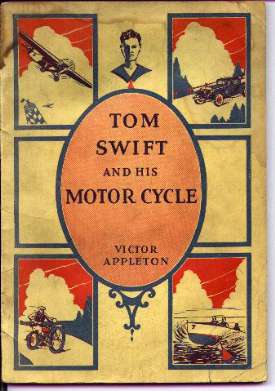 Speculation
As To Author's Identity-- The running gag about Mr. Damon's home town
(it keeps flip-flopping between Waterford and Waterfield during
the series) has not yet begun. It has been concluded elsewhere that the 1st
five volumes of this series were all written in toto by Edward
Stratemeyer, their creator. James Keeline states that specific documentation
exists tying the first two volumes of this series firmly to Harold Garis, a
ghost writer who is said by some to have penned most of these tales. Many later
volumes were sub-contracted to a whole series of ghost writers, who were
contractually unable to communicate with one another. Writing styles varied
enough that no one author (such as Garis) could have penned them all.
It is interesting to note that if Mr. Stratemeyer did write all of the 1st
five, even he couldn't keep the details straight. In Volume 1, 2 & 5, Mr.
D's home is Waterfield. In Volume 3, Waterford is "it" and in
Volume 4, no home town is specified. Frankly, the writing style in #4 is
enough different, that I'd hesitate to put any money on a bet that Ed
Stratemeyer did anything but outline these stories or possibly only review the
finished product.
Speculation
As To Author's Identity-- The running gag about Mr. Damon's home town
(it keeps flip-flopping between Waterford and Waterfield during
the series) has not yet begun. It has been concluded elsewhere that the 1st
five volumes of this series were all written in toto by Edward
Stratemeyer, their creator. James Keeline states that specific documentation
exists tying the first two volumes of this series firmly to Harold Garis, a
ghost writer who is said by some to have penned most of these tales. Many later
volumes were sub-contracted to a whole series of ghost writers, who were
contractually unable to communicate with one another. Writing styles varied
enough that no one author (such as Garis) could have penned them all.
It is interesting to note that if Mr. Stratemeyer did write all of the 1st
five, even he couldn't keep the details straight. In Volume 1, 2 & 5, Mr.
D's home is Waterfield. In Volume 3, Waterford is "it" and in
Volume 4, no home town is specified. Frankly, the writing style in #4 is
enough different, that I'd hesitate to put any money on a bet that Ed
Stratemeyer did anything but outline these stories or possibly only review the
finished product.
In spite of these inconsistencies, this particular tome has the right "feel" to have come from the pen of The Master. Perhaps The Master really was Garis, not Stratemeyer.
Errata--The few that were noticed were limited. Tom's deceased mother was named as Mrs. Barton, on p.9. During Tom's trip, Centreford and Pompville get reversed between pages 87 and 103. On p.128, the Blackford farm family was up and about at 10PM. Anyone who has ever worked a farm, knows that "early to bed, early to rise" is the order of the day, if you expect to get the chores done. Milk cows don't wait. 10PM would truly be the wee hours for a farm family if you are up at 4:00AM.
Geography--The 'look and feel' of upstate New York was authentic as described. Rolling hills and dense woods are common, even today. Many lakes dot the landscape, and several are far enough north and big enough to match a landmark like the fictional Lake Carlopa.
The only recognizable NY landmarks used in the story are Dunkirk ( in reality, on the shore of Lake Erie ) and Albany on the other ( eastern ) side of the state. These landmarks are separated by a distance of 285 miles as the crow flies. Much more so, by even modern roads. Shopton is described as a "village" on the east shore of Carlopa. Later, it is also said to be located on a river. The nearest "town" of any size is Mansburg (home to Mary Nestor.) Tom's home is described as being on an unpaved "country lane" and backs up to the wooded shore of Lake Carlopa. Shopton is described as being "one day's ride" via motor-cycle ( about 100 miles on unpaved roads) from Albany, and is apparently located along a major railroad line.
Only a "turnpike" that Tom travels, is described as being paved with Macadam.
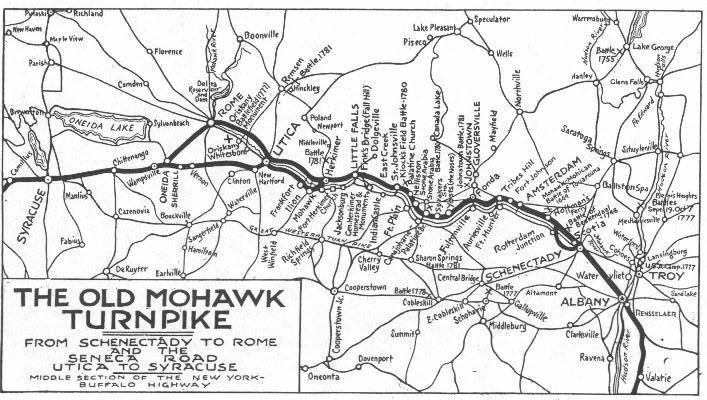
One
possibility for a location of Shopton could put it near the mid-line of
the state, possibly on the shore of Lake Oneida. Oneida is near
"the" Turnpike in that area, the Old Mohawk. ( See Illustration, above )
It would also be near at least one major RR line. Several lines follow the
Mohawk River Valley & Erie Canal. L. Oneida, however, does not
have the "numerous islands and bays" that play pivotal roles in later stories,
and is much wider in its east/west dimension than it is north/south. Plot
locations indicate a narrow east/west topography, easily crossed by a small open
boat. Oneida seems too large for this, and does not have the requisite
wooded hills on both shores.
The other possibility (and my favorite) is Lake George. It is some 90 miles north of Albany at its midpoint. It has the right shape and topography, but the only railroad connections in the early 1900's were not 'major.' One such line does sort of run up the east shore of the lake, and has a waypoint in the town of Dresden. Whitehall, NY is the nearest population center of any size, and could be the model for the fictional town of Mansburg. No listed "turnpikes" were found in the area. That area was pretty wild & wooly in the early 1900's. In spite of this, it's my best guess as a location for Tom's adventures.
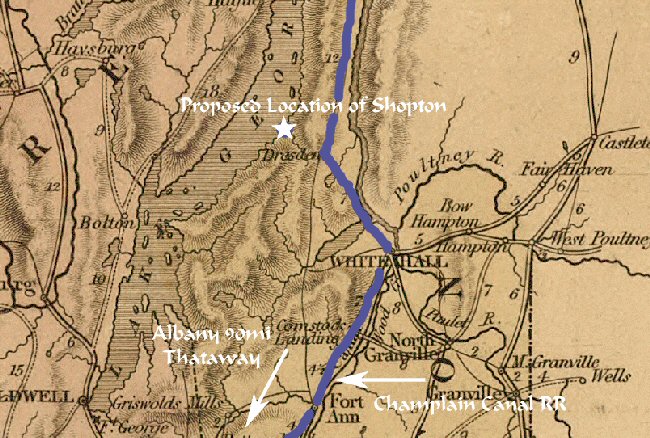
Northeastern New York State ca. 1900
Waypoints on the trip to Albany are Centreford, Pompville, Edgefield, and Fordham. In the story, Dunkirk is about "70 miles from Centreford." ( Dunkirk would be in the opposite direction from the route between either proposed Shopton location, above, and Albany.) Other population centers are Meadton, and Pineford, as well as well as Mansville and Reedville. Waterfield (sometimes home of Mr. Damon) is not given a direction, but is close enough for a casual ride via horse, bike or auto and could be modeled on Dresden, although, later Damon's home is stated to also be on Carlopa's shoreline.
JP Karenko 3/28/05 rev 2. 8/31/2006
![]()